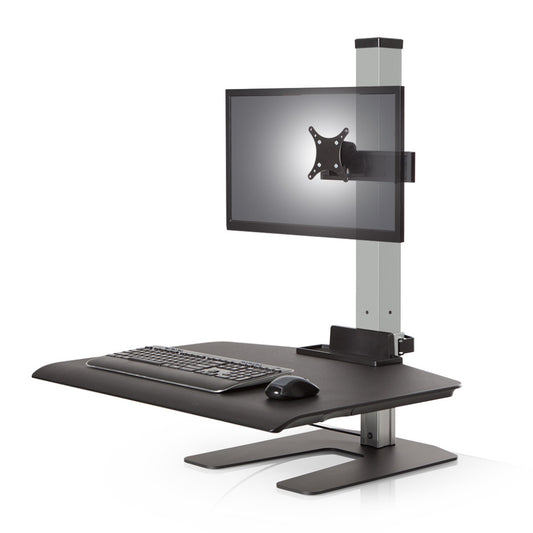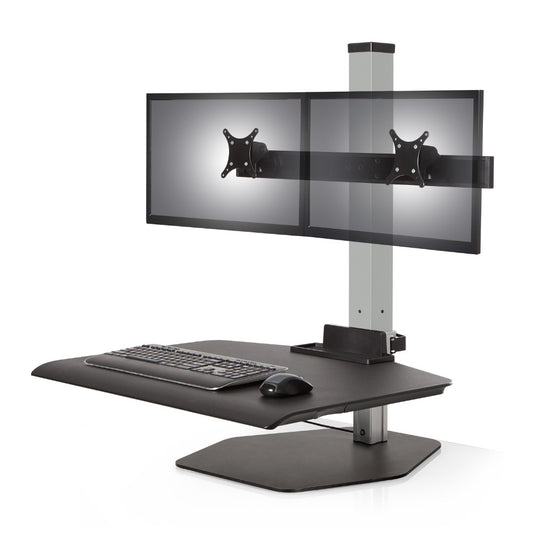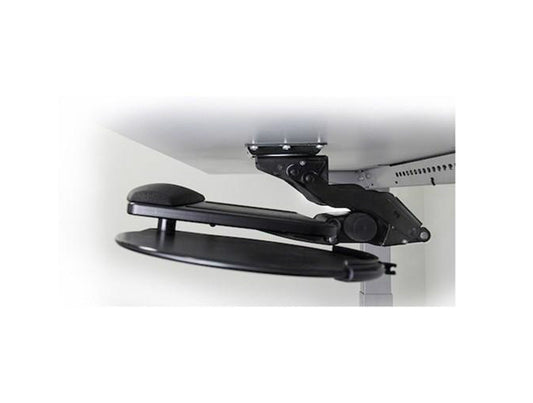Top Picks
-
Office Master PT69 Paramount Mid-Back Ergonomic Task Chair
Regular price $539.50Regular priceUnit price / per -
Office Master DB53 Discovery Back Ergonomic Task Chair Small-Petite
Regular price $429.00Regular priceUnit price / per -
Office Master PT73IU 24-7 Intensive Use Drafting Stool
Regular price $588.25Regular priceUnit price / per -
Office Master PT78 Paramount Mid-Back Adj. Lumbar Ergonomic Task Chair
Regular price $590.85Regular priceUnit price / per

Unlocking Comfort and Productivity
The human body is not designed to remain in the same position for hours at a time. Adjustable height workstations address this need to move and allow the user to change position frequently throughout the day. They are the foundation for any ergonomically equipped workspace and can be the single most effective means of achieving flexibility, maximizing comfort and increasing productivity in any office environment. Ergo Experts’ product offering features a wide selection of industry options and the flexibility to mix and match features to build the perfect workstation for virtually any application or budget.
We are the Ergo Experts!
ENHANCE YOUR COMFORT AND PRODUCTIVITY AT THE COMPUTER
-
Our products help you feel more comfortable and get more work done at the computer. Customize your workstation with ergonomic furniture and accessories tailored to your specific size and use patterns to enjoy improved productivity and comfort at home or the office. You'll also be reducing your risk of work-related injuries and helping to prevent the development of computer-related health conditions.
To make the biggest impact on your comfort we recommend starting with a height adjustable desk and/or an articulating keyboard tray system and monitor arm. Being able to fully adjust the positioning of your workstation provides a huge benefit to your overall well-being in front of the computer. With a proper ergonomic work space set-up you'll be able to work without discomfort whether you're sitting or standing up, and alternating between the two positions is what's recommended as the best practice.
The SmartMat anti-fatigue mat provides the means to avoid standing fatigue, and easily moves out of the way when switching from standing to sitting with a foot-activated release, you won't have to bend down to move the SmartMat out of the way of your chair.
Utilize an ergonomic chair to ensure optimal comfort and physical well-being when in the seated position.
See the recommendations below for setting up and using a proper ergonomic work station.
-
Discover Your Perfect Chair
-
Office Master PT69 Paramount Mid-Back Ergonomic Task Chair
Regular price $539.50Regular priceUnit price / per -
Office Master PT62 Paramount Low Back Ergonomic Task Chair
Regular price $475.15Regular priceUnit price / per -
Office Master PT74 Paramount Low Back Adj. Lumbar Ergo Task Chair
Regular price $539.50Regular priceUnit price / per -
Office Master DB53 Discovery Back Ergonomic Task Chair Small-Petite
Regular price $429.00Regular priceUnit price / per

These following details should be taken into consideration when selecting the right workstation for any application:
-
The size and shape of the workspace will determine the optimal size and shape of the work surface you select. Because adjustable height work surfaces move, you should allow 1" of clearance on each side, and 1" clearance as well in back of the work surface to avoid pinch points and scraping.
-
Understanding the work to be performed and the types of accessories to be used with the work surface are also key considerations. Workstations have many different types of frame supports and structures and some may not provide the clearances required for the installation of other key accessories such as adjustable monitor supports and keyboard trays.
-
The range of adjustability required is one of the most important considerations when selecting the right adjustable workcenter. BIFMA G1 2013 recommends a range of adjustability from 22.5" to 48.7" to accommodate the 5th to 95th percentile of the workforce.
-
Knowing the type of equipment to be used on the work surface is crucial when selecting an adjustable height workstation. When selecting a non-electric work center such as a crank or counter-balance table the weight of the equipment to be placed on the work surface will affect the amount of human force required to adjust the height of the workstation. The more force required, the less ergonomic the solution. All electric workstations also feature a weight limit rating to ensure that the motor is not overworked and the workstation moves efficiently throughout the life of the product. When comparing weight ratings it is important to clarify whether the weight rating includes the total weight of the work surface plus the equipment to be used, or the payload capacity after the weight of the work surface is taken into consideration.
-
For example, any product with a worksurface that will not go below 24.5" from the floor will not allow 50% of the female workforce (up to 5' 4" tall) to work in proper ergonomic position while seated. There are multiple options available that achieve full BIFMA range of adjustability as well as some that offer a limited range of adjustability.
STANDING ERGONOMIC GUIDELINES
-
1) Height Adjustment – Adjust the height of the work surface to a level approx. 1” below your rested elbow height level, and relax your shoulders. Gently rest your palms on a palm support. Avoid resting your wrists on the palm support.
2) Mousing – Move your mouse as close to your keyboard as possible. As with the palm support mentioned above, avoid using the mousing surface as an anchor, instead, allow the heel of your palm to glide over the mousing surface, using your entire arm when mousing.
3) Display – Your monitor should sit approx. an arm’s length away, with your eyes aligned at the same level as the top line of text, or slightly below. Adjust the monitor tilt so your line of sight is close to perpendicular to the monitor.
4) Alignment - Align the middle of your body with the monitor and spacebar, keep frequently used devices within easy reach.
5) Lighting - Utilize a task light on the side opposite side of your writing hand. Directed light at documents and away from monitor to maximize glare reduction.
6) Reset – Allow your body to recover from repetitive stress with two to three 30 to 60 second breaks each hour.
-
Optimize Your Workspace
-
Innovative WNST-1 Winston Single Desktop Sit-Stand Workstation
Regular price $810.00Regular priceUnit price / per -
Innovative WNST-2 Winston Dual Monitor Desktop Sit-Stand Workstation
Regular price $853.00Regular priceUnit price / per -
Innovative WNST-3 Winston TRIPLE Monitor Desktop Sit-Stand Workstation
Regular price $1,019.00Regular priceUnit price / per -
Innovative WNST-4 Winston QUAD Monitor Desktop Sit-Stand Workstation
Regular price $1,269.00Regular priceUnit price / per
SITTING ERGONOMIC GUIDELINES
-
1) Seat Height – Maintain seat level that ensures your thighs are parallel to the floor, keeping your feet flat on the floor (or footrest).
2) Seat Depth – Adjust seat depth (if available) to allow for two inches of clearance between the back of your knees and the front edge of the seat.
3) Back Height – Adjust height of chair back so that contour comfortably fits the small of your back.
4) Recline – Adjust the recline tension to support varying degrees of recline during the day. Avoid the use of recline locks.
5) Posture – Slightly lean back in a relaxed posture and allow the backrest to support your upper body.
6) Keyboard Tray – Position an articulating keyboard tray 1 to 1.5 inches above your thighs. Tilt the keyboard platform negatively (front edge higher than back edge) to keep wrists straight while typing. Rest your palms, but not your wrists, on any palm support placed in front of your keyboard.
7) Mousing – Move your mouse as close to your keyboard as possible. As with the palm support mentioned above, avoid using the mousing surface as an anchor, instead, allow the heel of your palm to glide over the mousing surface, using your entire arm when mousing.
8) Display – Your monitor should sit approx. an arm’s length away, with your eyes aligned at the same level as the top line of text, or slightly below. Adjust the monitor tilt so your line of sight is close to perpendicular to the monitor.
9) Lighting - Utilize a task light on the side opposite side of your writing hand. Directed light at documents and away from monitor to maximize glare reduction.
10) Alignment - Align the middle of your body with the monitor and spacebar, keep frequently used devices within easy reach.
11) Reset – Allow your body to recover from repetitive stress with two to three 30 to 60 second breaks each hour.
-
Unleash Your Typing Potential
-
Vanish Trackless Keyboard Tray System - Choose a Platform
Regular price From $279.00Regular priceUnit price / per -
ESI AA100 Short Track Keyboard Tray System
Regular price $357.00Regular priceUnit price / per -
Humanscale 6G500 Big Board Keyboard Tray System - QUICK SHIP
Regular price $349.00Regular priceUnit price / per -
Intellaspace SlimForm 19" Keyboard Tray System
Regular price $299.00Regular priceUnit price / per
ADDITIONAL CHAIR GUIDELINES:
-
Seat Width
The seat should be wider than the hip breadth of the user with allowance for movement and clothing. The seat width should not limit the ability to use the armrests comfortably.
-
Backrest Width
The width of the backrest should provide adequate support for the curvature of the user’s back without causing localized pressure points.
-
Lumbar Support
The height and shape of the lumbar support should coincide with the lumbar curve (’the small’) of the user’s back. The support should be firm, but not cause localized pressure points.
-
Seat Pan Angle
This should allow users to support their feet on the floor or footrest. They should not cause the user’s torso-to-thigh angle to be less than 90’. Forward seat pan angles should not cause users to shift excessive weight to their feet or experience the sensation of sliding out of the chair.
-
Backrest Height
All backrests should provide adequate lumbar support and buttocks clearance. For tasks requiring upper body mobility, the backrest should not interfere with the user’s movement. For users who prefer reclining postures or greater upper back support, the back height should provide support for the shoulder blades.
-
Armrest Height
This should allow users to sit in a variety of postures while supporting their forearms and/or elbows in a manner that avoids lifting the shoulders (armrests too high) or leaning to the side to reach the armrest (armrests too low). The armrest height should allow accessibility to, and performance of, tasks.
-
Movements of Seat and Back
The user should be able to sit in a position where the torso-to-thigh angle is equal to or greater than 90’. The seat and backrest angles should accommodate the varying postures assumed by the user throughout the day.
-
Armrest Length
The length of the armrest should allow users to sit close enough to the work surface to perform their tasks while maintaining contact with the backrest.



















